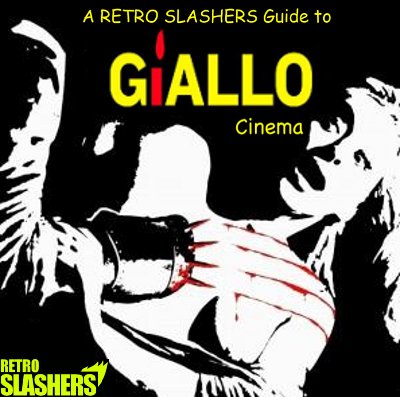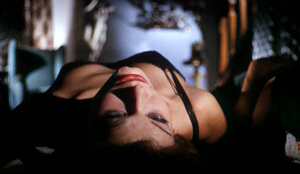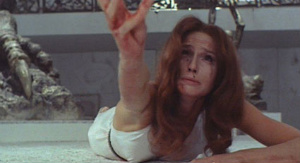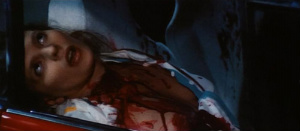
The slasher film took its inspiration from various sources, such as real life serial killers and literature, but one of its most obvious influences was the giallo, the Italian crime genre that was first bought to prominence in the 1960’s with the works of Mario Bava.These movies have become notorious over the years for their graphic portrayal of excessive violence and female nudity, resulting in many being accused of misogyny. Yet, just like the slasher, the giallo has battled criticism and controversy to become one of the most popular horror subgenres, helping to bring various Italian filmmakers international success. Faceless killers, blades tearing through flesh, the camera lusting over a naked body… these elements would become the standard slasher formula and echoes of Dario Argento can be seen in the likes of Halloween and Scream.
 Giallo was first popularised in the 1920’s as literature – crime novels bound in yellow sleeves (the word ‘giallo’ literally means ‘yellow’ in Italian) – by Mondadori Group, a publishing company formed by Arnoldo Mondadori in 1929, with the first book released being Tomaso Monicelli’s Aia Madama. These pulp novels became popular in Italy, with many drawing heavily from the likes of Sherlock Holmes, Agatha Christie and other English-speaking thrillers. Eventually, the work of Leonardo Sciascia and many of his contemporaries began to influence Italian cinema, with Bava’s La ragazza che sapeva troppo (aka The Girl Who Knew Too Much/The Evil Eye) being considered by many as the first giallo film, released in 1963 and starring American actor John Saxon (later seen in Black Christmas and A Nightmare on Elm Street). Bava had made his official directorial debut only three years earlier with La Maschera del demonio (aka Black Sunday), which would usher in the golder age of Italian horror cinema. Both these films would introduce the ‘whodunnit’ murder plot as a giallo standard.
Giallo was first popularised in the 1920’s as literature – crime novels bound in yellow sleeves (the word ‘giallo’ literally means ‘yellow’ in Italian) – by Mondadori Group, a publishing company formed by Arnoldo Mondadori in 1929, with the first book released being Tomaso Monicelli’s Aia Madama. These pulp novels became popular in Italy, with many drawing heavily from the likes of Sherlock Holmes, Agatha Christie and other English-speaking thrillers. Eventually, the work of Leonardo Sciascia and many of his contemporaries began to influence Italian cinema, with Bava’s La ragazza che sapeva troppo (aka The Girl Who Knew Too Much/The Evil Eye) being considered by many as the first giallo film, released in 1963 and starring American actor John Saxon (later seen in Black Christmas and A Nightmare on Elm Street). Bava had made his official directorial debut only three years earlier with La Maschera del demonio (aka Black Sunday), which would usher in the golder age of Italian horror cinema. Both these films would introduce the ‘whodunnit’ murder plot as a giallo standard.
The following year, Bava would direct his breakthrough thriller Sei donne per l’assassino (Blood and Black Lace), a full colour stalk and slash tale of a group of beautiful fashion models who are hacked to pieces one-by-one by a masked maniac, sporting a pair of black leather gloves. Each of the victims would be young women and in a state of undress, resulting in many critics accusing the movie of glorifying sexual violence. While Bava would continue his output with the mediocre Il Rosso segno della follia (Hatchet for the Honeymoon), a former journalist-turned-director would champion the giallo formula and take it to the next level with his debut L’Uccello dalle piume di cristallo (The Bird With the Crystal Plumage), the tale of an American tourist who witnesses an attempted murder, only to become convinced that the events he saw were somehow fabricated. The movie would introduce many trademarks and clichés that would recur throughout Argento’s career, such as a foreign protagonist wrongly suspected of murder, a psycho constantly taunting his victims with menacing phone calls and, as with Bava, the black gloved killer.
 A year later another, more controversial, director would become a major player in the giallo genre. Lucio Fulci, later more known for his notorious zombie flicks (Zombi 2, E tu vivrai nel terrore – L’aldilà) would helm the underrated thriller Una Lucertola con la pelle di donna (A Lizard in a Woman’s Skin), a more restrained and engaging horror that would later be replaced by pure splatter with his efforts. His next feature, Non si sevizia un paperino (Don’t Torture a Duckling), would prove even more popular and help cement his reputation as an interesting, if flawed, director. As Argento continued his successful run of giallos (with Il Gatto a nove code and 4 mosche di velluto grigio), other filmmakers attempted to capitalise on the genre’s new-found popularity, with the likes of Sergio Martino, Paolo Cavara and Giuliano Carnimeo enjoying minor acclaim.
A year later another, more controversial, director would become a major player in the giallo genre. Lucio Fulci, later more known for his notorious zombie flicks (Zombi 2, E tu vivrai nel terrore – L’aldilà) would helm the underrated thriller Una Lucertola con la pelle di donna (A Lizard in a Woman’s Skin), a more restrained and engaging horror that would later be replaced by pure splatter with his efforts. His next feature, Non si sevizia un paperino (Don’t Torture a Duckling), would prove even more popular and help cement his reputation as an interesting, if flawed, director. As Argento continued his successful run of giallos (with Il Gatto a nove code and 4 mosche di velluto grigio), other filmmakers attempted to capitalise on the genre’s new-found popularity, with the likes of Sergio Martino, Paolo Cavara and Giuliano Carnimeo enjoying minor acclaim.
Perhaps Argento’s most renowned work came with his 1975 thriller Profondo rosso, released in America as Deep Red, which took many of the elements of his earlier films and perfect them. A brutal yet stylish chiller, this would mark Argento’s introduction to the mainstream, allowing him to later make such masterpieces as Suspiria and Inferno. While Martino’s I Corpi presentano tracce di violenza carnale (Torso) and Andrea Bianchi’s Nude per l’assassino (Strip Nude for Your Killer) lacked the subtlety and style of many of its contemporaries, Pupi Avati’s La casa dalle finestre che ridono (The House with Laughing Windows) made more of an impression. Grizzly and gripping in equal measures, this proved that the genre still had some fresh ideas left to use.
 The early 1980’s saw the giallo slowly grind to a halt or, at least, drastically slow down, as the American slasher began to attract more attention. Fulci’s Lo Squartatore di New York (The New York Ripper) and Argento’s Tenebrae both fell foul of controversy in the UK while scoring minor successes in other countries. Yet the advancement and tolerance of prosthetics and graphic violence meant that style and suspense was being jettisoned in favour of the ‘money shot,’ much like the slasher. And with Bava passing away in 1980, expectations were high with his son, Lamberto Bava (who had worked as an assistant to his father on many films), though sadly much of his work would disappoint. Argento would eventually ditch the giallo formula, concentrating instead on more supernatural and erotic thriller, before finally returning to the genre with Non ho sonno (Sleepless) in 2001. With very few directors working in giallo today, public interest has dwindled over the years, with many horror fans now preferring their US slasher counterparts. Both Bava and Fulci are gone, as are many other filmmakers from the glory days of the ’70’s, but Argento still continues to produce a mixed bag, with his upcoming Giallo possibly set to re-establish them as one of the most beautifully poetic and violent genres in horror cinema.
The early 1980’s saw the giallo slowly grind to a halt or, at least, drastically slow down, as the American slasher began to attract more attention. Fulci’s Lo Squartatore di New York (The New York Ripper) and Argento’s Tenebrae both fell foul of controversy in the UK while scoring minor successes in other countries. Yet the advancement and tolerance of prosthetics and graphic violence meant that style and suspense was being jettisoned in favour of the ‘money shot,’ much like the slasher. And with Bava passing away in 1980, expectations were high with his son, Lamberto Bava (who had worked as an assistant to his father on many films), though sadly much of his work would disappoint. Argento would eventually ditch the giallo formula, concentrating instead on more supernatural and erotic thriller, before finally returning to the genre with Non ho sonno (Sleepless) in 2001. With very few directors working in giallo today, public interest has dwindled over the years, with many horror fans now preferring their US slasher counterparts. Both Bava and Fulci are gone, as are many other filmmakers from the glory days of the ’70’s, but Argento still continues to produce a mixed bag, with his upcoming Giallo possibly set to re-establish them as one of the most beautifully poetic and violent genres in horror cinema.
RECOMMENDED VIEWING:
La ragazza che sapeva troppo (The Girl Who Knew Too Much – 1963)
Sei donne per l’assassino (Blood and Black Lace – 1964)
Il rosso segno della follia (Hatchet for the Honeymoon – 1970)
L’uccello dalle piume di cristallo (The Bird with the Crystal Plumage – 1970)
Una lucertola con la pelle di donna (A Lizard in a Woman’s Skin – 1971)
Lo strano vizio della Signora Wardh (The Strange Vice of Mrs. Wardh – 1971)
4 mosche di velluto grigio (Four Flies on Grey Velvet – 1971)
La tarantola dal ventre nero (Black Belly of the Tarantula – 1971)
Non si sevizia un paperino (Don’t Torture a Duckling – 1972)
I corpi presentano tracce di violenza carnale (Torso – 1973)
La polizia chiede aiuto (What Have They Done to Your Daughters? – 1974)
Profondo rosso (Deep Red – 1975)
L’ultimo treno della notte (Night Train Murders – 1975)
La casa dalle finestre che ridono (The House With the Laughing Windows – 1976)
Lo squartatore di New York (The New York Ripper – 1982)
Tenebrae (Unsane – 1982)
La casa con la scala nel buio (A Blade in the Dark – 1983)
Deliria (Stage Fright – 1987)
Non ho Sonno (Sleepless – 2001)

10 Responses to A Retro Slashers Guide to Giallo Cinema